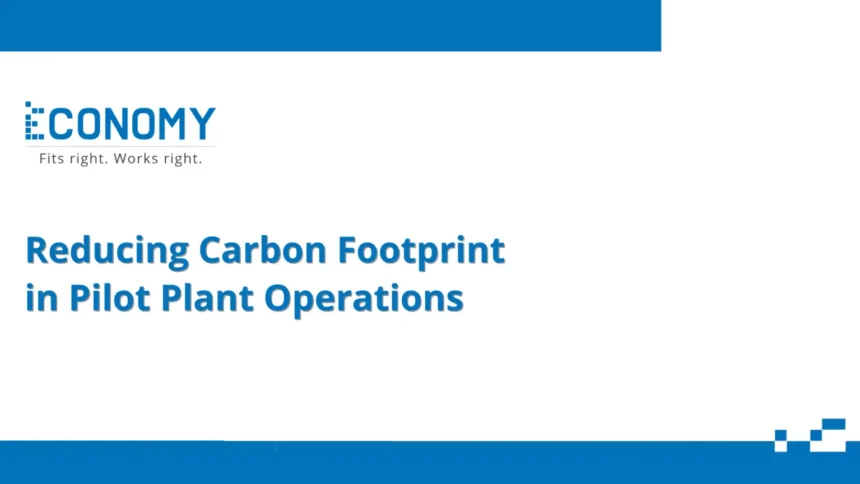Introduction To Reducing Carbon Footprint In Pilot Plant Operations
Reducing the carbon footprint in pilot plant operations has become increasingly crucial as the drive towards sustainability intensifies across various industries. Pilot plants play a vital role in the development and optimization of chemical processes, often serving as the proving ground for larger-scale industrial applications. As these facilities mimic full-scale production processes, their energy consumption and emissions can be significant. Hence, implementing strategies to minimize their carbon footprint is not just environmentally responsible but also economically beneficial in the long run.
Several advanced pilot plants, including liquid-liquid extractors (LLE), rising film and falling film evaporators, single stage short path distillation units (SPDU), agitated thin film evaporators (ATFE), agitated thin film dryers (ATFD), and lab evaporator set-ups, present unique opportunities for carbon footprint reduction. These technologies can be optimized for energy efficiency, reduced material waste, and improved process integration. By incorporating innovative design features, utilizing renewable energy sources, and implementing effective monitoring and control systems, pilot plant operations can significantly lower their environmental impact.
Sustainable Practices In Liquid-Liquid Extractor (Lle) Pilot Plants
In Liquid-Liquid Extraction (LLE) pilot plants, adopting sustainable practices can significantly reduce the carbon footprint of operations. One primary approach is optimizing solvent selection. Utilizing bio-based or green solvents such as water or ethanol instead of petrochemical-based options can minimize environmental impact. Efficient solvent recycling methods also play a crucial role; integrating closed-loop systems ensures minimal solvent waste, reducing the need for fresh solvent production and disposal-associated emissions.
Energy efficiency is another critical aspect. Process intensification techniques, such as using counter-current flow configurations and high-efficiency mixing, can drastically improve mass transfer rates, thereby lowering energy consumption. Implementing process simulations and control systems to fine-tune operating conditions further minimizes energy demands. Utilizing renewable energy sources to power extraction equipment can also substantially cut down greenhouse gas emissions.
Energy Efficiency In Rising Film & Falling Film Evaporator Pilot Plants
Energy efficiency is a critical factor in the design and operation of rising film and falling film evaporator pilot plants, essential for reducing the overall carbon footprint of these facilities. These evaporators are widely employed in various industries for concentrating solutions, such as in the food, pharmaceutical, and chemical sectors. One primary strategy for enhancing energy efficiency in these systems is optimizing the heat transfer process.
Carefully monitoring and adjusting the operation parameters like feed rate, temperature, and vacuum can significantly reduce energy consumption.
Minimizing Emissions In Single Stage Short Path Distillation Unit (Spdu) Pilot Plants
In pilot plant operations focused on reducing carbon footprint, the single stage short path distillation unit (SPDU) presents unique opportunities for minimizing emissions. This highly efficient distillation method is well-suited for the separation of heat-sensitive compounds due to its ability to operate at lower temperatures, thereby reducing the energy consumption compared to traditional distillation methods. To further minimize emissions in SPDU pilot plants, the integration of advanced vacuum systems can play a crucial role.
These systems not only lower the boiling points of the compounds being separated, thus necessitating less thermal energy, but also help in capturing and condensing volatiles efficiently, preventing their release into the atmosphere. Implementing precise thermal management practices, such as using heat exchangers, can optimize energy use, ensuring that excess heat is recycled within the system. Additionally, the adoption of automation and digital monitoring can result in real-time adjustments that enhance process efficiency, thereby reducing unnecessary energy consumption and emissions.
Carbon Reduction Strategies For Agitated Thin Film Evaporator (Atfe) Pilot Plants
Reducing the carbon footprint in Agitated Thin Film Evaporator (ATFE) pilot plants necessitates a multi-pronged approach focused on energy efficiency and process optimization. The utilization of advanced control systems can significantly reduce energy consumption by ensuring the ATFE operates within its optimal parameters. Implementing heat recovery systems that capture and reuse thermal energy from the process can also lead to substantial energy savings.
Additionally, optimizing the feed material properties, such as viscosity and flow rate, can minimize the energy required for agitation and evaporation. Regular maintenance of the ATFE and its components, including seals, bearings, and agitator blades, ensures efficient operation and prevents unnecessary energy losses. Employing renewable energy sources, such as solar or wind power, to supply the electrical needs of the pilot plant further enhances sustainability.
Eco-Friendly Approaches For Agitated Thin Film Dryer (Atfd) Pilot Plants
Eco-friendly approaches for agitated thin film dryer (ATFD) pilot plants focus on minimizing energy consumption and waste production, as well as optimizing process efficiency. First, employing high-efficiency motors and variable frequency drives can significantly cut down energy usage by adapting the power supply to the operational needs. The adoption of renewable energy sources such as solar or wind power can further lower the carbon footprint.
Moreover, implementing advanced automation and control systems allows for precise monitoring and adjustment of process parameters, reducing inefficiencies and waste. The integration of heat recovery systems can capture and reuse energy that would otherwise be lost, thus enhancing overall energy efficiency. Material selection is another key consideration; using corrosion-resistant and durable materials can prolong the lifespan of the equipment, reducing the need for frequent replacements.
Green Innovations In Lab Evaporator Set-Up Pilot Plants
Green innovations in lab evaporator set-up pilot plants are essential for reducing the carbon footprint of laboratory-scale chemical processes. One significant advancement is the integration of energy-efficient technologies such as heat pumps and energy recovery systems. These systems capture and reuse heat that would otherwise be wasted, significantly reducing energy consumption. Additionally, the use of vacuum technology in conjunction with evaporators lowers the boiling point of solvents, enabling evaporation at lower temperatures and thus reducing the overall energy requirement.
Innovations in solvent recovery further enhance the sustainability of lab evaporator operations. Advanced solvent management systems allow for the recapture and purification of used solvents, minimizing waste and decreasing the need for fresh chemical inputs. This closed-loop approach not only conserves resources but also reduces hazardous waste generation.






